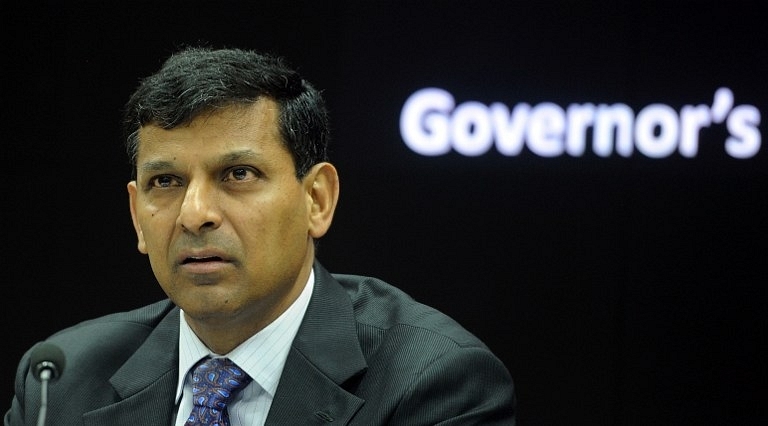Economy
Status Quo: Rajan Decides Not To Rock Markets Before He Leaves Mint Street
- Raghuram Rajan delivered no negative or positive surprises in his last bimonthly monetary policy, just four weeks before hanging up his boots on 4 September.
- The highlight of Rajan’s policy was the central bank’s continued “accommodative” stance, which means it wants to keep the market liquid.
- Rajan’s tenure is ending on a whimper rather than a roar, but that is exactly what conservative bankers should be doing.

Reserve Bank of India (RBI) governor Raghuram Rajan
Raghuram Rajan delivered no negative or positive surprises in his last bimonthly monetary policy, announced today (9 August), just four weeks before hanging up his boots on 4 September.
The repo rate remained at
6.5 percent, the reverse repo at six percent and the cash reserve ratio (CRR) at four percent. The reverse repo is the rate at which banks park money with the
Reserve Bank of India (RBI) and the repo is the rate at which the RBI lends
overnight money to banks short of liquidity. The CRR is money banks locked up
with the RBI, earning no interest.
This no-change policy
will be the last one delivered by a Governor on a standalone basis; the next one
will be delivered by a committee in which the RBI Governor will only be one
voice.
The formal stance of the latest
policy is thus defensive, since Rajan does not want to rock the boat before he
leaves. He is also not convinced inflation has been licked. The policy notes
that the risks to retail inflation remain on the “upside”, thanks to the likely
impact of the Seventh Pay Commission from this month onwards. It says: “Risks to
the inflation target of 5 percent for March 2017 continue to be on the upside.”
Rajan also believes that the Pay Commission could impact “inflation
expectations” and hence the need for caution “so as to pre-empt a
generalisation of inflation pressures. In terms of immediate outcomes, much
will depend on the benign effects of the monsoon on food prices.”
Given that the RBI has agreed
to target four percent inflation all the way to 2021 (but within a band of two
percent on either side), the current retail inflation rate of 5.8 percent is
clearly worrisome. The agreement between the government and the RBI says that
the latter cannot allow inflation to rise above six percent for more than
three-quarters at a time. There is a chance that CPI inflation may breach the six
percent mark in the next two prints
One can, of course,
question whether interest rates have that direct an impact on inflation, but
they certainly impact expectations and the RBI has to do what it has to do. So
rate cuts are unlikely to happen in a hurry even after Rajan leaves Mint
Street. The six-member Monetary Policy Committee that will determine interest
rates after Rajan leaves will now have to pick up from where he left off.
Far from changing rates, the highlight of Rajan’s policy was the central bank’s continued “accommodative” stance, which means it wants to keep the market liquid. In his June policy, Rajan promised to open the floodgates so that the inter-bank money market shifts from a situation of one percent deficit (on net demand and time liabilities) to a neutral stance. In part, this easy liquidity is the result of high government spending in the first months of the year when taxes haven’t quite started coming in; but the RBI also wants banks to be cash-flush to repay over $26 billion of non-resident deposits which will be due to be repaid in the September-November period.
While some of the deposits may well be renewed, banks will need to
exchange rupees for dollars for those who want their money back. This will need
huge liquidity support as banks have to pay rupees to get dollars, which could
tighten the money market. The CRR cut may happen if banks face a large sudden outflow of non-resident deposits, which seems likely.
Rajan’s tenure is ending on a whimper rather than a roar, but that is exactly what conservative bankers should be doing. The best bankers are those who do not make waves that unsettle the markets.
Support Swarajya's 50 Ground Reports Project & Sponsor A Story
Every general election Swarajya does a 50 ground reports project.
Aimed only at serious readers and those who appreciate the nuances of political undercurrents, the project provides a sense of India's electoral landscape. As you know, these reports are produced after considerable investment of travel, time and effort on the ground.
This time too we've kicked off the project in style and have covered over 30 constituencies already. If you're someone who appreciates such work and have enjoyed our coverage please consider sponsoring a ground report for just Rs 2999 to Rs 19,999 - it goes a long way in helping us produce more quality reportage.
You can also back this project by becoming a subscriber for as little as Rs 999 - so do click on this links and choose a plan that suits you and back us.
Click below to contribute.
Latest